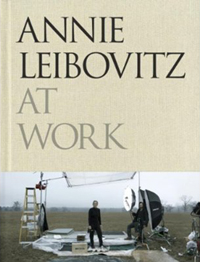Annie Leibovitz at Work

Annie Leibovitz is arguably the best-known photographer in the U.S.A. (Who else? Richard Avedon? Herb Ritts? Ron Gallela?) Based on years of service at hippie-qua-boomer journal Rolling Stone, where she shot 142 covers, and her ongoing work at effete boomer glossy Vanity Fair, as well as other such magazines and a plethora of ad campaigns have made Leibovitz’s celebrity images a ubiquitous staple of mainstream culture. All of which may obscure her fundamental achievement—which is to have created a body of work that succeeds, as Susan Sontag wisely observed, in accomplishing what “all photographs aspire to the condition of being memorable—that is, unforgettable.”
One of my favorites is her shot of Keith Haring nude and painted white with his signature illustrations and hieroglyphics adorning his body and the background. Or Bette Midler nude lying in a bed of roses. Of course I could go on. Leibovitz latest opus, Annie Leibovitz at Work (Random House), inter-splices her images with observations about some of her more well-known efforts (the Nixon resignation) and mild revelations from her splendid career:
The first thing I did with my very first camera was climb Mt. Fuji. Climbing Mt. Fuji is a lesson in determination and moderation. It would be fair to ask if I took the moderation part to heart. But it certainly was a lesson in respecting your camera. If I was going to live with this thing, I was going to have to think about what that meant. There were not going to be any pictures without it.
If you need to read a review of At Work, Thomas Mallon’s is spot on, delivering this punch line:
“At Work” includes a picture of the photographer’s mother, Marilyn Leibovitz, shot in 1997. These days it “means more and more” to the daughter who took it, because of its honesty: “My mother is looking at me as if the camera were not there.” This is not a condition easily replicated when the photographer isn’t the subject’s flesh and blood, and it doesn’t obtain almost anywhere else in the book, which is fine, since Leibovitz’s work, apart from a 1990s foray into Sarajevo, has never really been about honesty. As “At Work” makes clear, it has been about performance and arrangement—of the highest and shiniest order.
